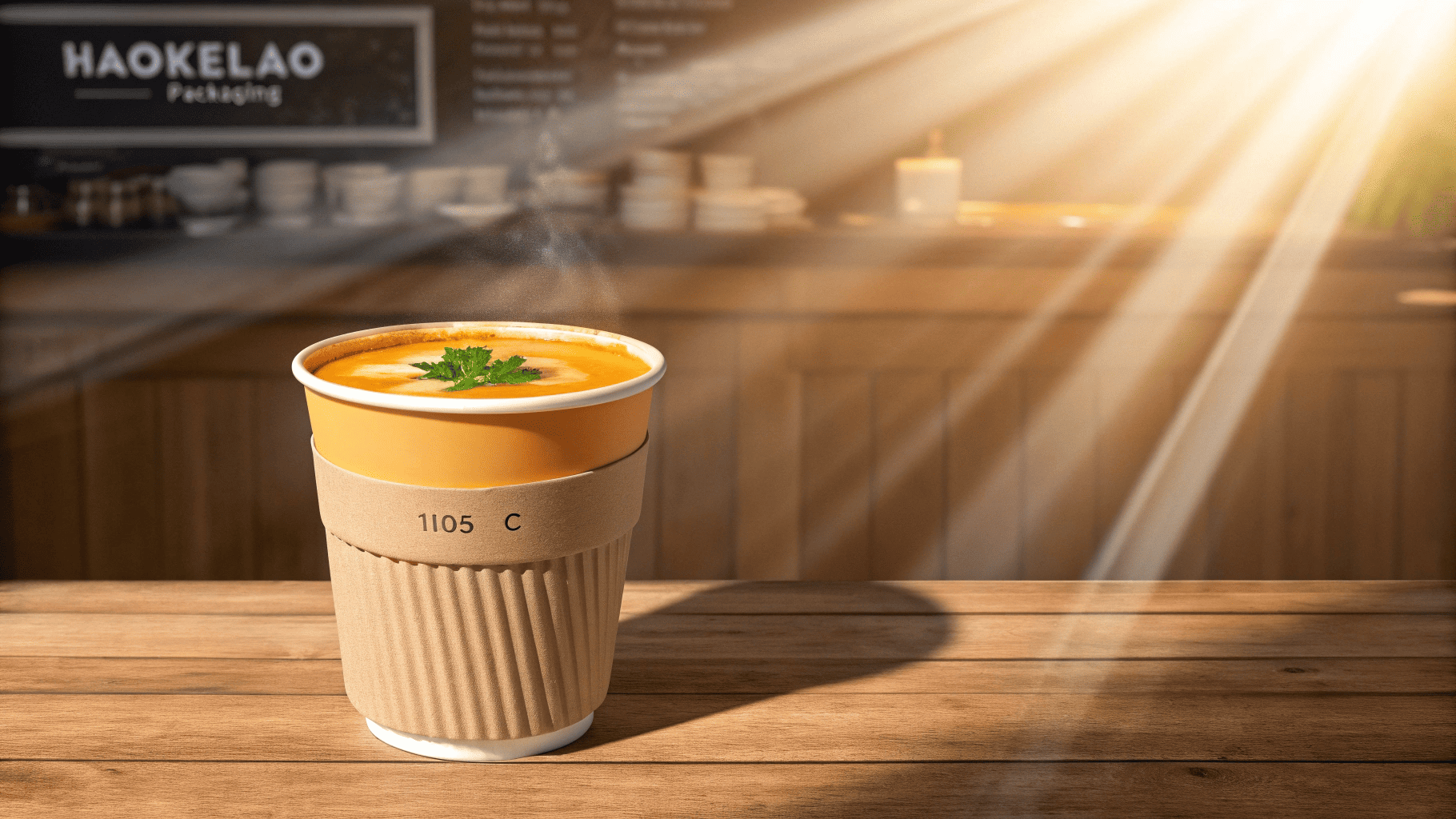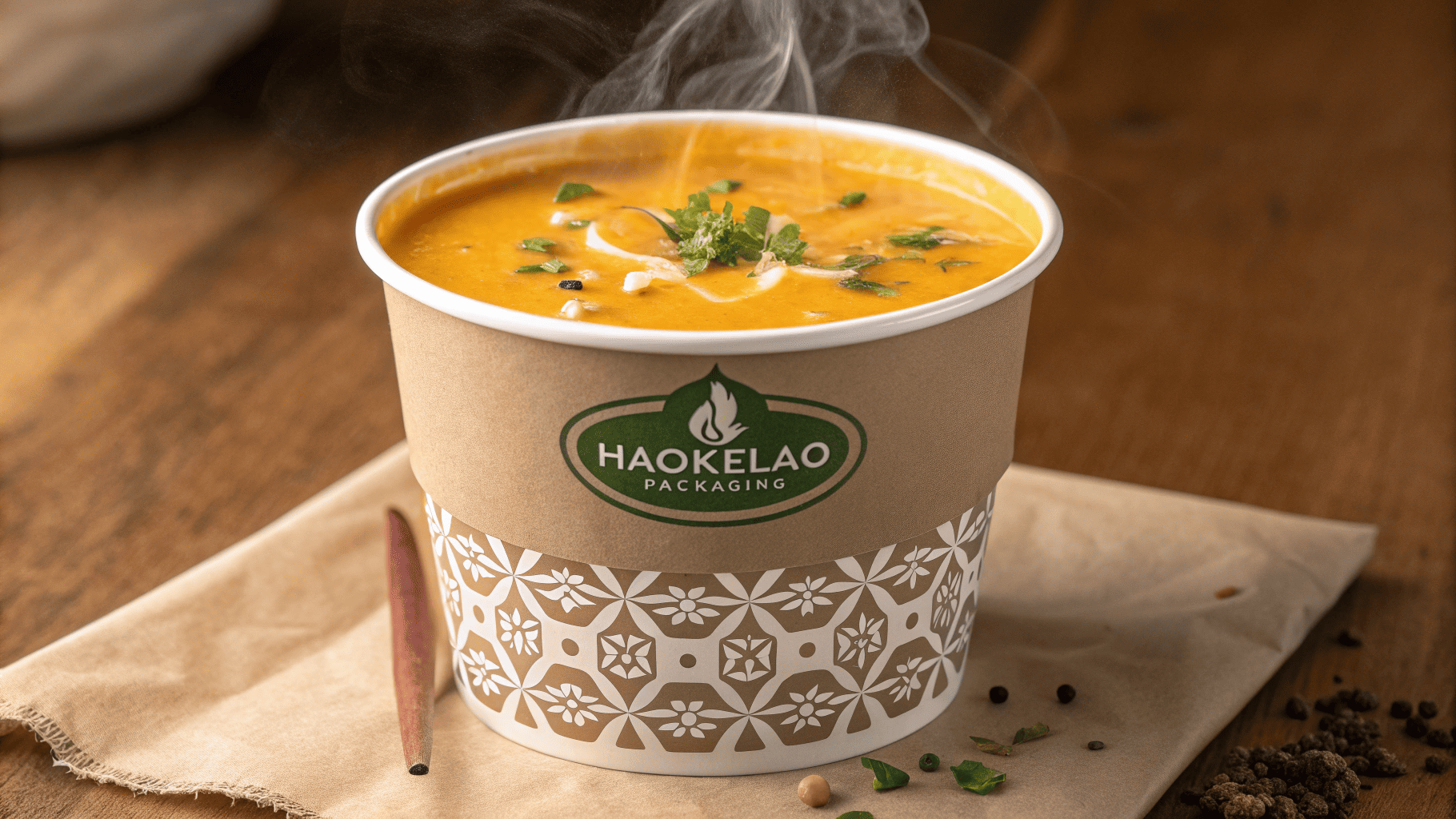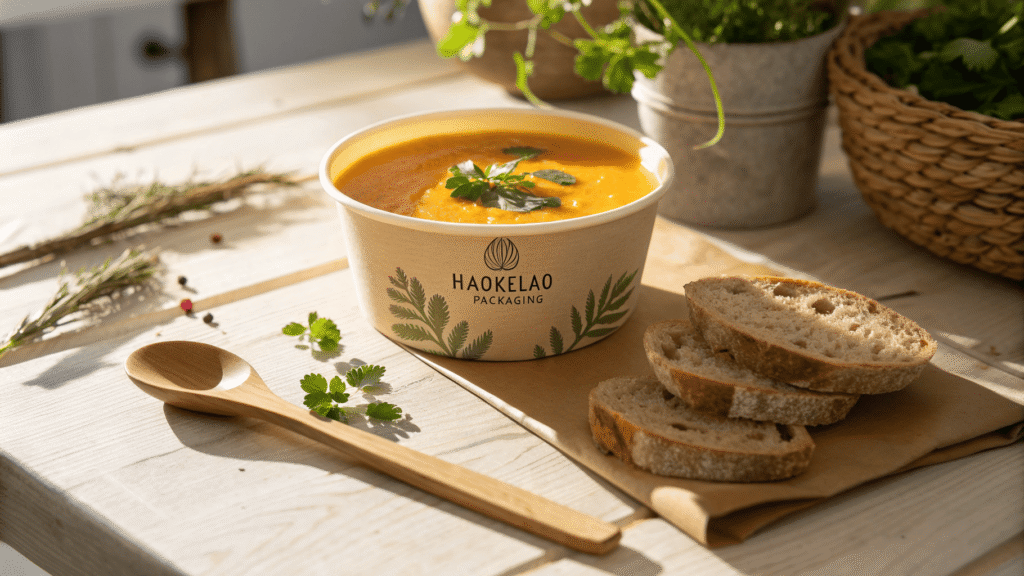You’re about to serve fresh, steaming soup, but you hesitate. Can a simple paper bowl handle the heat, keep the soup from leaking, and still be safe for your customers to enjoy?
Yes, modern disposable paper bowls are safe for hot soup when they use food-grade paper and quality PE (polyethylene)1 or PLA (polylactic acid)2 inner coatings. These bowls can withstand high temperatures and prevent leaks, making them reliable for soup service.

Paper bowls may look basic, but their structure is more advanced than most people realize. Quality soup paper bowls start with food-grade virgin pulp and an inner coating that resists heat and moisture. Some even feature a double-layer wall3 or corrugated jacket4 for extra insulation, reducing the chance of burned hands. The quality of the coating, the thickness of the paper, and the sealing method all determine whether a paper bowl is truly soup-safe.
Are paper bowls okay for hot soup?
Paper bowls might seem the same on the shelf, but differences in design and material quality can make or break your service.
Yes, paper bowls are fine for hot soup if they have a proper PE or PLA anti-leak coating and are from a certified manufacturer5. Double-layer or heavy-duty bowls6 work best for very hot soups or long holding times.

In my experience, soups at 85–95°C can be served safely in paper bowls with good coatings. For longer holding times (over an hour) or temperatures close to boiling, I recommend bowls with a high-heat PE coating7 or an aluminum-laminated interior8.
For example, brands like Starbucks and Costa adapted their hot drink cup technology into soup-safe designs, using double-wall bowls with embossed surfaces for better grip and insulation. Hotpot delivery chains in China add an inner bag inside the paper bowl to make transportation safer.
Heat Performance by Bowl Type
| Bowl Design | Recommended Heat Range | Holding Time Suitable for Soup | My Professional Insight |
|---|---|---|---|
| Single-wall PE-coated | Up to 100–105°C | Best for 15–30 minutes | Economical choice. Great for quick-serve soups, but handle with care for prolonged holding times. |
| Double-wall or corrugated PE-coated | Up to 105–110°C | 30–60 minutes | Excellent insulation, reduces burn risk for customers and improves soup temperature retention. |
| PLA-coated (eco-friendly) | Up to 90–100°C | 15–30 minutes | Perfect for sustainable brands. Works well for most soups, but avoid long storage of near-boiling liquid. |
| PE-coated + Inner Foil Layer | Up to 110–120°C | 1 hour+ | Extremely durable. Ideal for heavy delivery and high-temperature soups like bone broth or hotpot base. |
Are all paper soup containers safe?
It’s tempting to think any paper container works, but some are simply not made for liquids.
No, not all paper containers are safe for soup. Wax-coated or uncoated paper bowls will fail with hot liquids—they leak, soften, and may release unwanted substances. Only use bowls designed and rated for hot foods.

I’ve seen wax-coated ice cream cups used for soup service, and the result is always bad. Wax melts at 50–60°C, leaving a greasy film and leaks. Uncoated paper is even worse—it works for dry snacks but collapses instantly with liquids.
This is why top-tier businesses always work with verified suppliers9. In Japan, convenience stores like Lawson and 7-Eleven have already replaced plastic with compostable paper bowls for miso soup and oden, but these are designed specifically for heat, with reliable coatings and tight seams.
Safe vs Unsafe Paper Bowls
| Bowl Type | Suitable for Hot Soup? | Common Issues When Unsafe |
|---|---|---|
| PE-coated food-grade bowl | ✅ | Rare issues if from reputable maker |
| PLA-coated eco bowl | ✅ | Slightly lower heat tolerance; avoid prolonged boiling |
| Wax-coated cold cup | ❌ | Wax melts, contaminates soup, causes leaks |
| Uncoated paper bowl | ❌ | Rapid absorption, collapse, burns from spills |
What is the best material for a soup bowl?
Your choice of soup bowl material shapes the safety, branding, and customer experience of your service.
The best choices for disposable soup bowls are thick PE-coated paper, eco-friendly PLA-coated10 paper, or bagasse fiber bowls11 with proper waterproof lining. They balance safety, heat resistance, and leak prevention.

I’ve provided soup packaging for both boutique cafes and massive chain restaurants. My top picks are PE-coated double-wall paper bowls for durability and insulation, or PLA-coated bagasse bowls for brands that prioritize sustainability.
Delivery-focused brands like Haidilao use thick corrugated paper bowls with inner sealed bags to transport boiling soup bases safely. In the US, Panera Bread offers compostable PLA-coated bowls for take-out soups—proving that sustainability and performance can go hand in hand.
Conclusion
Yes, paper bowls are safe for soup—if they’re PE or PLA-coated and built for hot liquids. Avoid wax-coated or uncoated bowls and choose the right design for your soup’s heat and holding time.
Learn how PE coatings enhance the safety and durability of paper bowls for hot liquids. ↩
Discover the eco-friendly advantages of PLA coatings for sustainable soup serving. ↩
Explore how double-layer walls provide insulation and prevent burns. ↩
Find out how corrugated jackets improve insulation and handling. ↩
Choosing certified manufacturers ensures the quality and safety of your bowls. ↩
Find out when to use heavy-duty bowls for optimal performance. ↩
Understand the significance of high-heat coatings for very hot soups. ↩
Learn how aluminum-laminated interiors enhance durability and heat retention. ↩
Working with verified suppliers guarantees quality and safety. ↩
Discover how eco-friendly options can be both sustainable and effective. ↩
Explore the benefits of bagasse fiber bowls as a sustainable alternative. ↩
